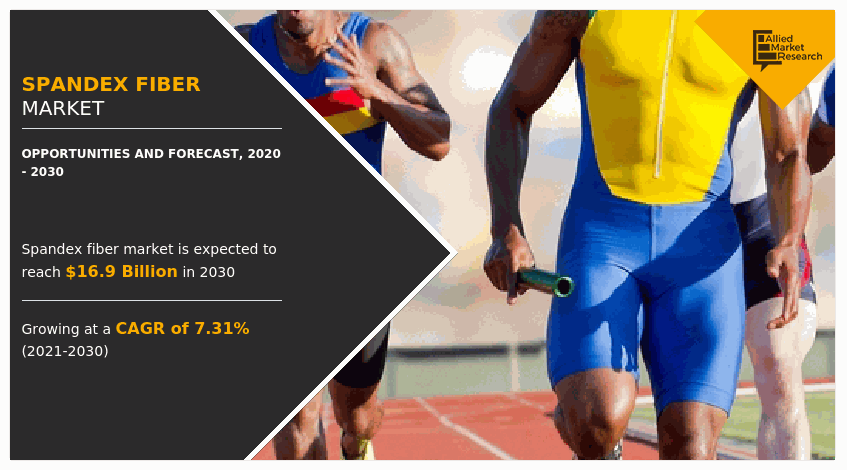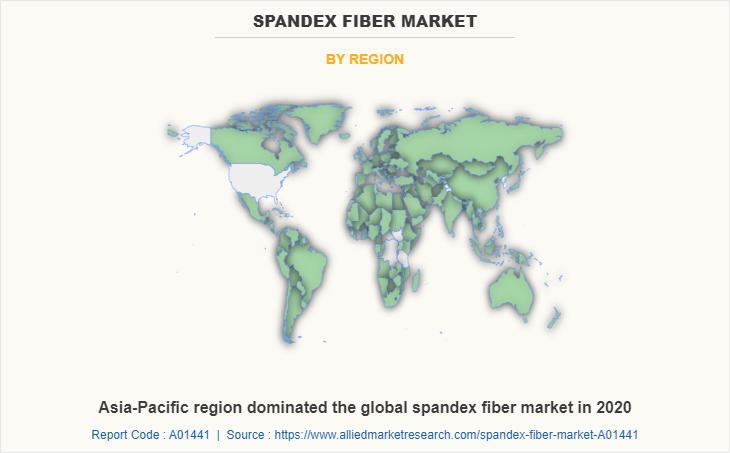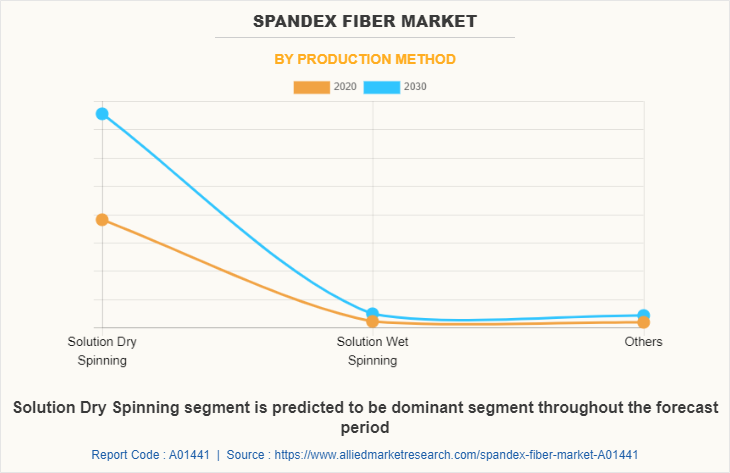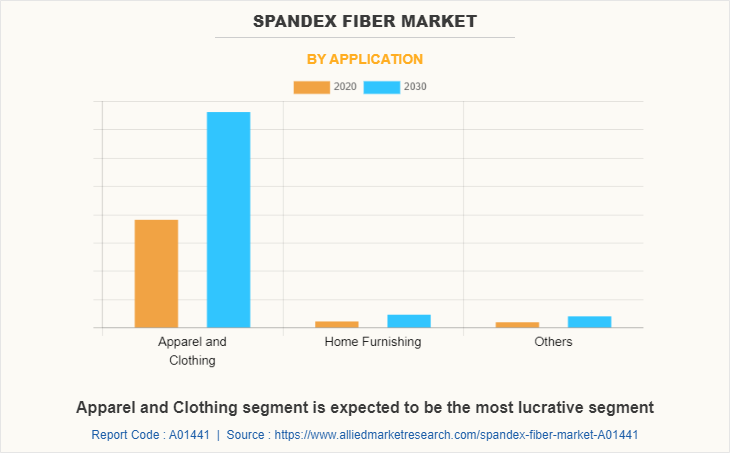Spandex Fiber Market Research, 2030
The global spandex fiber market was valued at $8.4 billion in 2020, and is projected to reach $16.9 billion by 2030, growing at a CAGR of 7.31% from 2021 to 2030.
Spandex fiber is a synthetic fiber, manufactured from the long chain of polyurethane, also called as lycra or elastane. This fiber is known for its exceptional elasticity and is more durable than rubber. It is lightweight, dyeable, and has excellent abrasion resistance. In comparison with other elastic materials, spandex fiber material does not get frayed when tailored. It has wide range of applications in the textile industries, including its use for tailoring swimming wear, cycling wear, and for casual wear. In addition, it is used as raw material to manufacture healthcare related products, including surgical gloves and baby diapers. The global spandex fiber market growth is driven considerably, owing to growth in population and change in fashion trends. Furthermore, development of bio-based raw material products is attributed to change in market dynamics of spandex fibers in the textile sector.

Demand for spandex fiber is increasing from various industry verticals, including textile and automotive, owing to its extensive set of properties, such as elasticity, durability, and resistance to ultra violet light. Spandex fiber is widely used in textile industries to make stretchable clothing. Furthermore, surge in demand for bandages, medical housing, and diapers from healthcare sector fuel the growth of the spandex fiber market share across the globe throughout the forecast period. Increase in awareness among individuals regarding personal healthcare and growth in income of middle class individuals in developing countries led to change in living standards hence, driving the growth of the spandex fiber market during the forecast period.
Fluctuating prices of spandex fiber, due to global crude oil price fluctuations, availability of substitutes, and stringent government regulations hinder the growth of the market. Increase in investment in R&D of spandex fiber is anticipated to offer lucrative growth opportunities for the market during the forecast period.
The global spandex fiber market is segmented on the basis of type of production method, application, and region.
According to the type of production method, it is segmented into solution dry spinning, solution wet spinning, and others. Depending on application, it is categorized into apparel & clothing, home furnishing, and others. The apparel & clothing segment accounted for the highest market share, owing to increase in utilization of spandex fiber products in various clothes and major sport equipment. Region wise, it is analyzed across North America, Europe, Asia-Pacific, and LAMEA. Asia-Pacific is the leading region in terms of demand for spandex fiber, and is expected to maintain its dominance during the forecast period. The high adoption of spandex fiber products in the region continue to boost the growth of spandex fiber market size, due to presence of huge population base and presence of many developing countries in this region.
The key players operating in the global spandex fiber market are Hyosung Corporation, Invista, Asahi Kasei Corporation, Toray Industries, Inc., Indorama Industries Ltd., TK Chemical Corporation, Zhejiang Huafon Spandex Co. Ltd., Xiamen Lilong Spandex Co., Ltd., Yantai Spandex Co., Ltd., and Taekwang Industrial Co. Ltd.
Other players in the value chain include Xinxiang Bailu Chemical Fibre Group Co. Ltd., Baoding Swan Spandex Co., Ltd., Spandex Corporation Ltd., Jiangsu Shuangliang Spandex Co., Ltd., Highsun Group, and Yantai Tayho Advanced materials Co. Ltd. are competing for the share of the market through product launch, joint venture, partnership, and expanding the production capabilities to meet the future demand for the spandex fiber market in the forecast period.

Asia-Pacific occupies the largest part of the spandex fiber market and consists of countries, including China, India, Japan, South Korea, Australia, and rest of Asia-Pacific. Population growth coupled with industrialization is driving the growth of the spandex market in Asia-Pacific. Rise in demand for clothing, including inner wear, sportswear, and active wear, on account of the higher disposable income levels and growth in popularity of various sports and leisure activities drive the market growth. According to the Indian Brand Equity Foundation (IBEF), India’s textile and apparel exports accounted for $38.70 billion in 2019 and is expected to increase to $82.00 billion by 2021, subsequently driving the growth of the spandex fiber market. Moreover, increase in manufacturing activities, owing to government initiatives in the developing countries, including India and China stimulate the growth of the market. For instance, in 2019, the government of Malaysia allocated a sum of $7 billion to public health sector, an increase of 7.8% from 2018. In 2019, the Australian government announced $5 billion, a 10-year investment plan for Medical Research Future Fund (MRFF) as a part of its 2019–20 budgets to support Australian health and medical research. Increase in healthcare investments in various regions of Asia-Pacific positively impacts the development of the market during the forecast period.

The solution dry spinning segment dominates the global spandex fiber market. Solution dry spinning is most cost efficient process in fiber manufacturing. Fibers manufactured through this process offer better elastic recovery, which is the reason for the largest market share compared to other production methods. In dry spinning fiber production, prepolymer (produced by mixing macro glycol with a diisocyanate monomer) is reacted with an equal amount of diamine. This is known as a chain extension reaction. The resulting solution is diluted with a solvent to produce spinning solution. Solvent helps to make the solution thinner and more easily handled. At last, the spinning solution is pumped into a cylindrical spinning cell , in which it is cured and converted into fibers. Dry spinning technique is used only for polymers which cannot be melt and spun, owing to safety and environmental concerns associated with solvent handling.

The apparels & clothing segment dominates the global spandex fiber market. For clothing, spandex is usually mixed with cotton/rayon/polyester or nylon fiber depending on the fabric. Spandex fibers are durable and retains original length and shape after stretching. Spandex fibers are used in formulation of intimate apparel and hosiery, Owing to these properties, which, in turn, augments the growth of the spandex fiber market. According to the International Trade Center, revenue generated by import of stockings, socks and other hosiery items grew by 2%, reaching $2,449.8M in 2019. Thus, increase in demand for apparel and expansion of textile industries across the globe fuel the growth of the market. Spandex fiber has prominent elasticity and chemical properties, which makes it a popular choice in textile industry. Increase in demand for the activewear and sportswear for competitive water-related activities drive the growth of textile industry. Moreover, clothing apparel brands invest in spandex fiber-based apparel and garments. For instance, Invista, the owner of Lycra launched bio-based spandex in the form of apparel and garments. The fiber is made out of renewable butanediol, which is derived from corn, encouraging consumers to purchase it. Furthermore, the consumers' shift toward the eco-friendly products is expected to proliferate the growth of the market.
COVID-19 Impact Analysis:
COVID-19 has severely impacted the global economy with devastating effects on global trade, which has simultaneously affected households, business, financial institution, industrial establishments, and infrastructure companies. The spread of COVID-19 moderately impacted this market. Increase in demand for healthcare products during pandemic led to rise in demand for spandex fiber in the production of surgical gloves, masks, and other medical cloths. Stringent regulation of the government toward the shutdown of transportation sector led to increase in the difficulty in procurement of raw materials. Furthermore, pandemic led to decline in efficiency at the manufacturing sites, due to low labor force.
Key Benefits For Stakeholders
- This report provides a quantitative analysis of the market segments, current trends, estimations, and dynamics of the spandex fiber market analysis from 2020 to 2030 to identify the prevailing spandex fiber market opportunities.
- The market research is offered along with information related to key drivers, restraints, and opportunities.
- Porter's five forces analysis highlights the potency of buyers and suppliers to enable stakeholders make profit-oriented business decisions and strengthen their supplier-buyer network.
- In-depth analysis of the spandex fiber market segmentation assists to determine the prevailing market opportunities.
- Major countries in each region are mapped according to their revenue contribution to the global market.
- Market player positioning facilitates benchmarking and provides a clear understanding of the present position of the market players.
- The report includes the analysis of the regional as well as global spandex fiber market trends, key players, market segments, application areas, and market growth strategies.
Spandex Fiber Market Report Highlights
| Aspects | Details |
| By Production Method |
|
| By Application |
|
| By Region |
|
| Key Market Players | Yantai Spandex Co., Ltd., invista, Zhejiang Huafon Spandex Co. Ltd., Xiamen Lilong Spandex Co., Ltd., Asahi Kasei Corporation, Indorama Industries Ltd., Hyosung Corporation, Taekwang Industrial Co. Ltd., Toray Industries, Inc., TK Chemical Corporation |
| Other players in the value chain include | Xinxiang Bailu Chemical Fibre Group Co. Ltd., Baoding Swan Spandex Co., Ltd., Spandex Corporation Ltd., Jiangsu Shuangliang Spandex Co., Ltd., Highsun Group, Yantai Tayho Advanced materials Co. Ltd. |
Analyst Review
Spandex fiber is also known as elastane or Lycra; which is a synthetic fiber known for its exceptional elasticity. It is a man-made fiber that is lightweight and smooth. It is abrasion-resistant and demonstrates negligible damage from needle cutting when stitched as compared to other elastic materials. In addition, it provides durability, resistance against body oils, perspiration, lotions, detergents, and no static or pilling problems.
The spandex fiber is widely used in manufacturing of athletic, aerobic, exercise apparel, swim and bathing suits, brassiere straps& bra side panels, ski pants, slacks, hosiery, socks, belts, surgical hose, bicycle pants, and shaped garments.
The market for spandex fiber is growing at a rapid pace, due to its application in swimming and cycling garments across the globe. Governments of several countries focus on encouraging students to participate in sports. In addition, rise in demand for rapid dry and comfortable fabrics for activewear is one of the key factors driving the growth of the market. Increase in awareness among individuals regarding healthcare products led to increase in demand for diapers, compression stockings, surgical hoses, and bandages across the globe. Rise in utilization of spandex in automotive industry to make door panel fabrics is positively influencing the market.
Rising demand and growing application scope in end-user industries and high performance properties coupled with rising acceptance of spandex fiber are the key factors boosting the spandex fiber market growth
The market value of spandex fiber in 2030 is expected to be US$ 16.87 Billion
Hyosung Corporation, Invista, Asahi Kasei Corporation, Toray Industries, Inc., Indorama Industries Ltd., TK Chemical Corporation, Zhejiang Huafon Spandex Co. Ltd., Xiamen Lilong Spandex Co., Ltd., Yantai Spandex Co., Ltd., and Taekwang Industrial Co. Ltd.
Clothing and apparel application is projected to increase the demand for spandex fiber
The global spandex fiber market is segmented on the basis of production method, application, and region. Depending on production method, it is segmented into solution dry spinning, solution wet spinning, and others. According to application, it is categorized into apparel and clothing, home furnishing, and others. Region wise, it is analyzed across North America, Europe, Asia-Pacific, and LAMEA.
Expansion in the emerging regions such as Asia-Pacific to provide new opportunities is the main driver of spandex fiber market
Apparel, clothing and home furnishing applications are expected to drive the adoption of spandex fiber market
COVID-19 pandemic mixed impact over the spandex fiber market in 2022. Increase in demand for healthcare products during pandemic led to rise in demand for spandex fiber in the production of surgical gloves, masks, and other medical cloths. Stringent regulation of the government toward the shutdown of transportation sector led to increase in the difficulty in procurement of raw materials thereby hampering the growth of spandex fiber market in 2022.
Loading Table Of Content...



